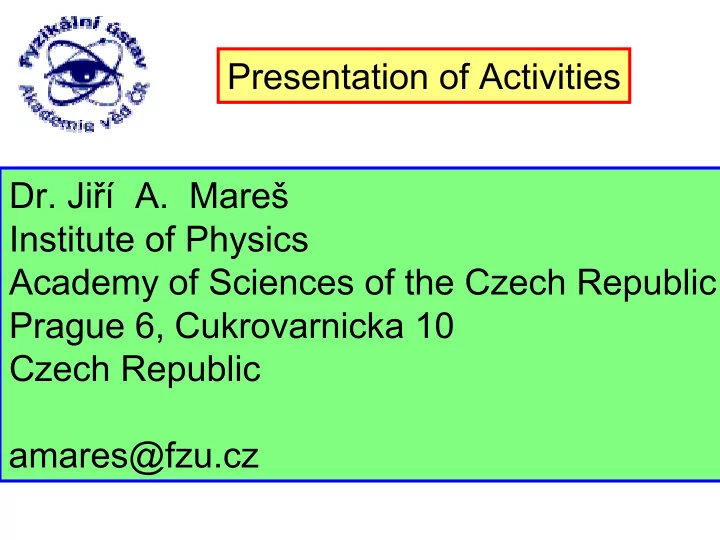

Presentation of Activities Dr. Ji ř í A. Mareš Institute of Physics Academy of Sciences of the Czech Republic Prague 6, Cukrovarnicka 10 Czech Republic amares@fzu.cz
Experimental set-up for scintillation response studies using HPMT 241 Am (59.6 keV) excited lines of Cu, Rb, Mo, Ag, Ba, and Tb, 57 Co, 22 Na, 137 Cs and 60 Co Here, we use α -ray sources α -ray sources – 241 Am, 239 Pu instead of γ -rays and 244 Cm Quantum efficiency of the HPMT DEP 30 25 Q.E. [%] 20 15 10 5 0 200 300 400 500 600 700 800 Wavelength [nm] Pulsed height spectra ORTEC model 672 MCA ORTEC Model 927 MCB
Photoelectron response of the HPMT Bias – voltage at the Si PIN diode anode ➣ ➣ High voltage – between the photocathode focusing electrodes and the anode SIGNAL 10 8 Counts - no bias – no voltage no bias -no voltage 10 7 20 V bias - 6 kV dark current, light n = 1 40 V bias - 6 kV 10 6 40 V bias - 10 kV 40 V bias - 12 kV long 10 5 - bias – HV voltage – 10 4 n = 2 signal appear 1000 n = 3 n = 4 - nominal bias – voltage 100 photoelectrons appear 10 calibration is possible 1 0 100 200 300 400 500 Channel number
Gamma-ray pulse spectra of 662 keV line of the 137 Cs source with YAG:Ce measured for different sample thickness 6000 Counts Sample thickness 5000 1 mm 2 mm 4000 5 mm 10 mm 3000 Arrows - 662 keV peak position 2000 1000 0 200 300 400 600 100 500 0 Channel number These gamma-ray spektra show that • YAG:Ce has lower photo-peak efficiency compared with LuAG:Ce (photo- peak/Compton edge ~ 0.26 for 10 mm thickness) due to lower density (4.55 g/cm 3 ) it is necessary to use longer crystals (lower attenuation than has LuAG:Ce) • YAG:Ce could be efficient for detection with the avalanche photodiodes
HPMT se-up at CERN developed during late nineties of past century for scintillation characteristics of large PWO crystals
Carmelo D’ Ambrosio shows the HPMT set-up Carmelo Jiri
Measurements at CERN – Ing. A. Beitlerová
HPMT scintillation set-up at the Laboratory of Luminescence and Scintillation Materials in Prague
Projects are supported by the Czech Committee for cooperation with CERN (from Ministry of Trade and Industry or later by Ministry of education, Youth and Sport PHOS – photon calorimeter Gamma a alfa spektroskopie scintilátor ů FZÚ – Department of Optical Materials – study of scintillation crystals RD-18 project – “Search for new radiation hard scintillators for new generation of electromagnetic calorimeters at LHC” Crystals: Ce-, Pr-doped garnets, perovskites, silicates. PbWO 4 and other ones
All-Russian Science Research Institute of the Experimental Physics - VNIIEF MECHANICAL DESIGN of the PHOS CRADLE MECHANICAL DESIGN of the PHOS CRADLE PHOS CRADLE Project - schema General information General information The overall dimensions of the PHOS Cradle. The total weight is around 3,5 t
End of 2004 year – CRADLE produced at TENEZ factory in Chotebor, Czech Republic
JUNE 2005 - PHOS CRADLE assembled at CERN Point 2 by people from TENEZ factory TENEZ people MARES
PHOS CRADLE is moving down into experimental position – CERN, Point 2, St. Genis CRADLE Rollers
PHOS CRADLE in the final position below the collision space of ALICE LHC experiment PHOS CRADLE
PHOS CRADLE position – November 2008 – Point 2 ALICE LHC
Detail of PHOS CRADLE – November 2008 – ALICE LHC
Works on or around PHOS CRADLE are not easy
CERN – Point 2 – ALICE LHC space – with Martin Faltys Jiri Martin
One PWO module is in the centre of PHOS CRADLE holder module
With Dmitry Budnikov from VNIIEF in Sarov at PHOS assembling hall at CERN Dmitry Budnikov from Sarov Jiri from Praha
With Karel Polak at the read side of one PHOS PWO module at the assembling hall at CERN Karel Polak Jiri Mares
Front side of one of the PHOS PWO modules - individual PWO crystals are clearly seen
CERN - November 2009 – control screen of PHOS detector at the ALICE CONTROL ROOM at Point 2
CERN - Point 2– November 2009 – ALICE CONTROL ROOM - PHOS CONTROL Jiri Mares Petr Zavada
CERN – Point 2 – November 2009 - PHOS control New start of LHC and first collisions
CERN – Point 2 – ALICE CONTROL ROOM – first collision November 23, 2009
CERN – Point 2 – ALICE CONTROL ROOM – people see first ciollisions
CERN – picture of inner part of LHC, especially Of magnets
Recommend
More recommend